Page 97 of 250
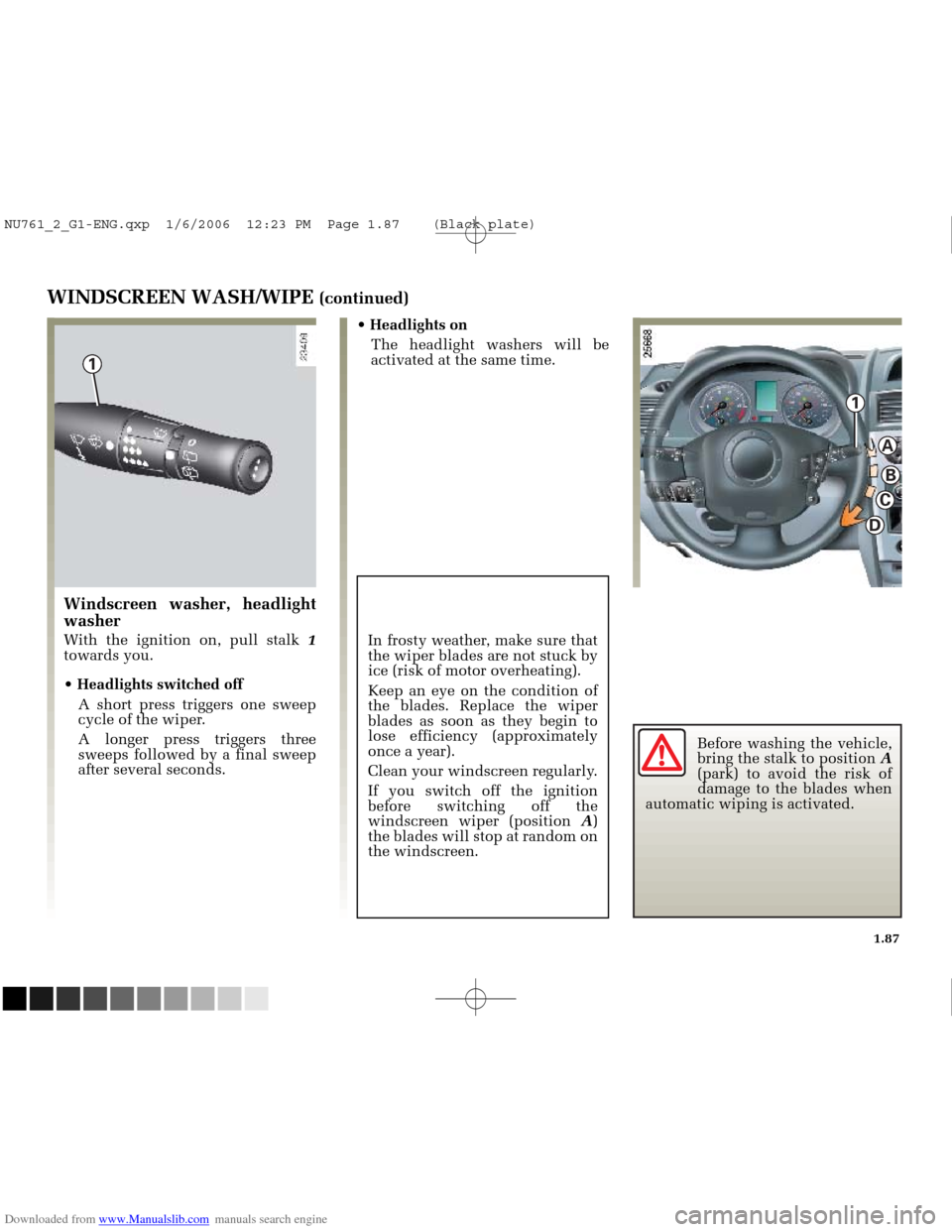
Downloaded from www.Manualslib.com manuals search engine
1
1
C
B
A
D
NU761_2_G1-FRA.qxd 10/11/05 15:55 Page 1.87
1.87
Before washing the vehicle,
bring the stalk to position A
(park) to avoid the risk of
damage to the blades when
automatic wiping is activated.
WINDSCREEN WASH/WIPE (continued)
In frosty weather, make sure that
the wiper blades are not stuck by
ice (risk of motor overheating).
Keep an eye on the condition of
the blades. Replace the wiper
blades as soon as they begin to
lose efficiency (approximately
once a year).
Clean your windscreen regularly.
If you switch off the ignition
before switching off the
windscreen wiper (position A)
the blades will stop at random on
the windscreen.
Windscreen washer, headlight
washer
With the ignition on, pull stalk 1
towards you.
Headlights switched off
A short press triggers one sweep
cycle of the wiper.
A longer press triggers three
sweeps followed by a final sweep
after several seconds. Headlights on
The headlight washers will be
activated at the same time.
NU761_2_G1-ENG.qxp 1/6/2006 12:23 PM Page 1.87 (Black plate)
Page 100 of 250
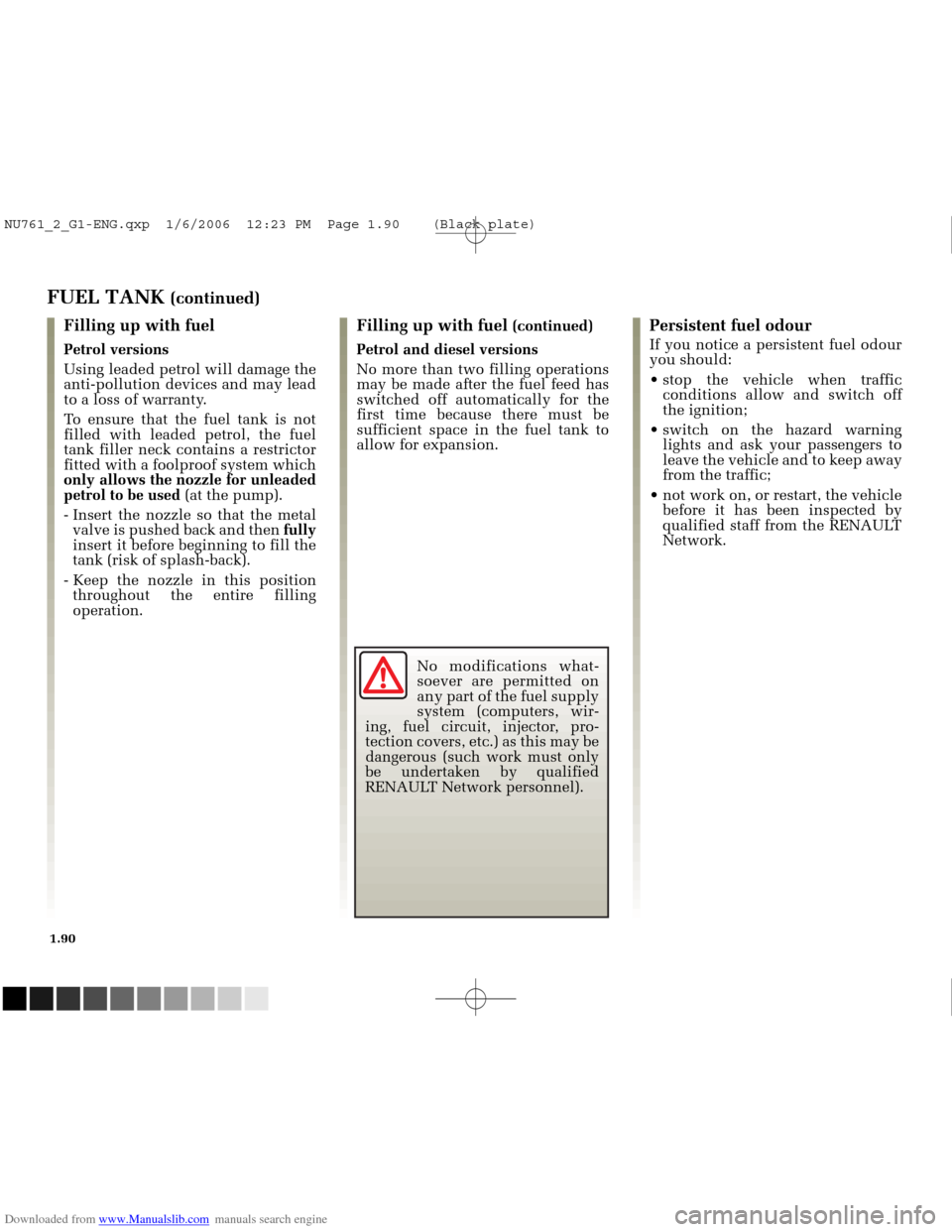
Downloaded from www.Manualslib.com manuals search engine
NU761_2_G1-FRA.qxd 10/11/05 15:55 Page 1.90
1.90
No modifications what-
soever are permitted on
any part of the fuel supply
system (computers, wir-
ing, fuel circuit, injector, pro-
tection covers, etc.) as this may be
dangerous (such work must only
be undertaken by qualified
RENAULT Network personnel).
FUEL TANK (continued)
Filling up with fuel
Petrol versions
Using leaded petrol will damage the
anti-pollution devices and may lead
to a loss of warranty.
To ensure that the fuel tank is not
filled with leaded petrol, the fuel
tank filler neck contains a restrictor
fitted with a foolproof system which
only allows the nozzle for unleaded
petrol to be used (at the pump).
- Insert the nozzle so that the metal valve is pushed back and then fully
insert it before beginning to fill the
tank (risk of splash-back).
- Keep the nozzle in this position throughout the entire filling
operation.
Persistent fuel odour
If you notice a persistent fuel odour
you should:
stop the vehicle when traffic conditions allow and switch off
the ignition;
switch on the hazard warning lights and ask your passengers to
leave the vehicle and to keep away
from the traffic;
not work on, or restart, the vehicle before it has been inspected by
qualified staff from the RENAULT
Network.
Filling up with fuel (continued)
Petrol and diesel versions
No more than two filling operations
may be made after the fuel feed has
switched off automatically for the
first time because there must be
sufficient space in the fuel tank to
allow for expansion.
NU761_2_G1-ENG.qxp 1/6/2006 12:23 PM Page 1.90 (Black plate)
Page 106 of 250
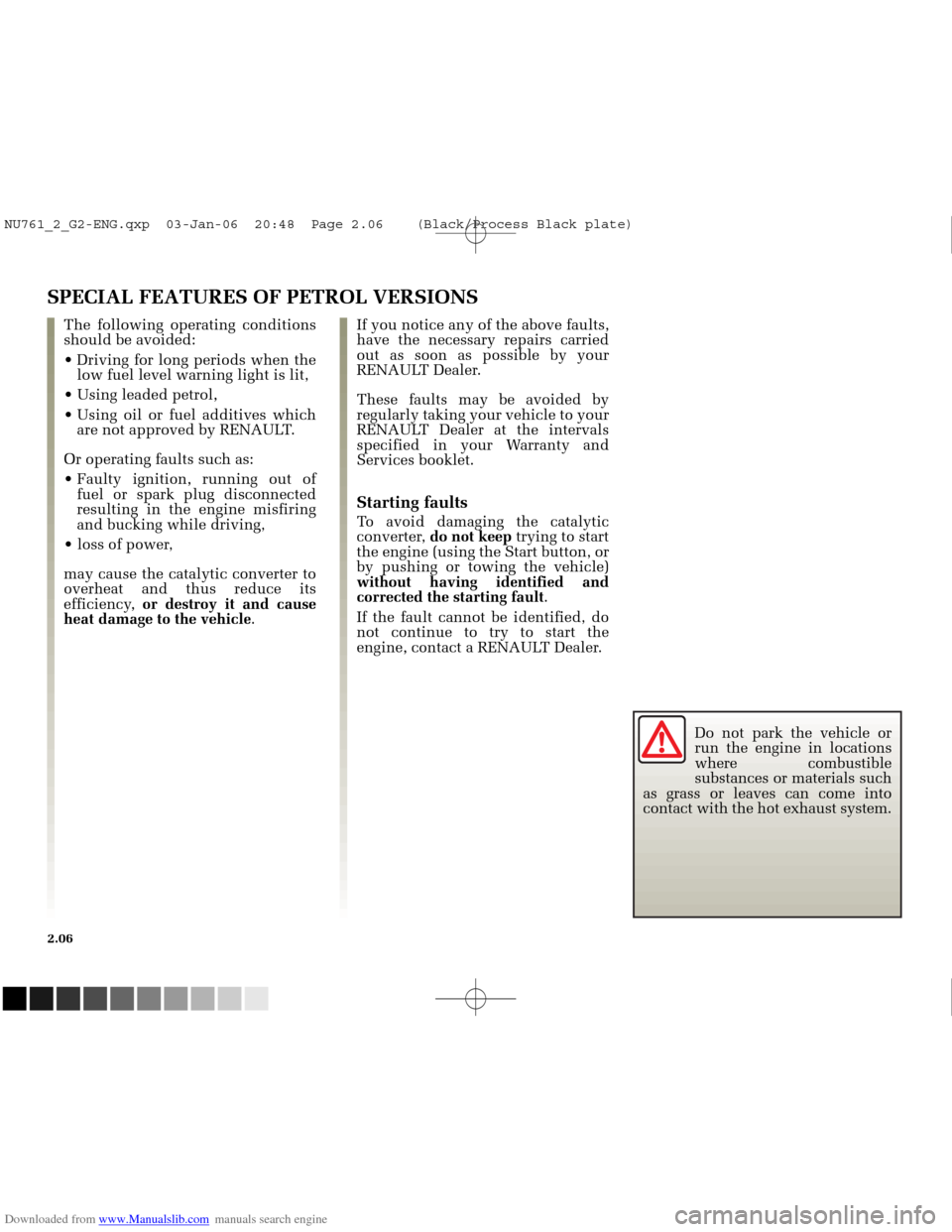
Downloaded from www.Manualslib.com manuals search engine
NU761_2_G2-FRA.qxd 4/11/05 10:48 Page 2.06
2.06
SPECIAL FEATURES OF PETROL VERSIONS
If you notice any of the above faults,
have the necessary repairs carried
out as soon as possible by your
RENAULT Dealer.
These faults may be avoided by
regularly taking your vehicle to your
RENAULT Dealer at the intervals
specified in your Warranty and
Services booklet.
Starting faults
To avoid damaging the catalytic
converter, do not keep trying to start
the engine (using the Start button, or
by pushing or towing the vehicle)
without having identified and
corrected the starting fault .
If the fault cannot be identified, do
not continue to try to start the
engine, contact a RENAULT Dealer.
The following operating conditions
should be avoided:
low fuel level warning light is lit,
are not approved by RENAULT.
Or operating faults such as:
fuel or spark plug disconnected
resulting in the engine misfiring
and bucking while driving,
may cause the catalytic converter to
overheat and thus reduce its
efficiency, or destroy it and cause
heat damage to the vehicle .
Do not park the vehicle or
run the engine in locations
where combustible
substances or materials such
as grass or leaves can come into
contact with the hot exhaust system.
NU761_2_G2-ENG.qxp 03-Jan-06 20:48 Page 2.06 (Black/Process Black\
plate)
Page 108 of 250
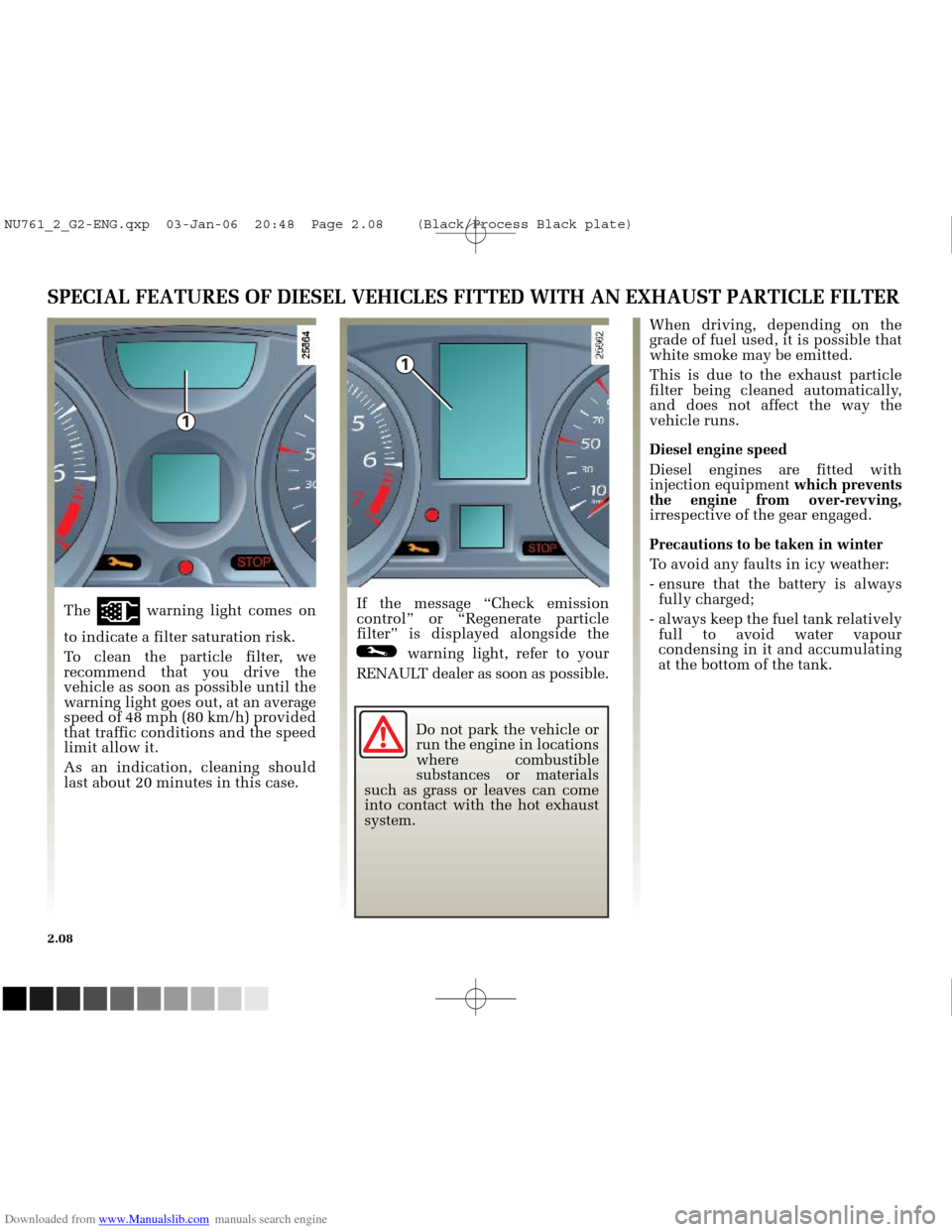
Downloaded from www.Manualslib.com manuals search engine
1
1
NU761_2_G2-FRA.qxd 4/11/05 10:48 Page 2.08
2.08
SPECIAL FEATURES OF DIESEL VEHICLES FITTED WITH AN EXHAUST PARTICLE FILT\
ER
When driving, depending on the
grade of fuel used, it is possible that
white smoke may be emitted.
This is due to the exhaust particle
filter being cleaned automatically,
and does not affect the way the
vehicle runs.
Diesel engine speed
Diesel engines are fitted with
injection equipment which prevents
the engine from over-revving,
irrespective of the gear engaged.
Precautions to be taken in winter
To avoid any faults in icy weather:
- ensure that the battery is always fully charged;
- always keep the fuel tank relatively full to avoid water vapour
condensing in it and accumulating
at the bottom of the tank.
Do not park the vehicle or
run the engine in locations
where combustible
substances or materials
such as grass or leaves can come
into contact with the hot exhaust
system.
The warning light comes on
to indicate a filter saturation risk.
To clean the particle filter, we
recommend that you drive the
vehicle as soon as possible until the
warning light goes out, at an average
speed of 48 mph (80 km/h) provided
that traffic conditions and the speed
limit allow it.
As an indication, cleaning should
last about 20 minutes in this case.
If the message “Check emission
control” or “Regenerate particle
filter” is displayed alongside the
warning light, refer to your
RENAULT dealer as soon as possible.
NU761_2_G2-ENG.qxp 03-Jan-06 20:48 Page 2.08 (Black/Process Black\
plate)
Page 109 of 250
Downloaded from www.Manualslib.com manuals search engine
1
2
NU761_2_G2-FRA.qxd 4/11/05 10:48 Page 2.09
GEAR LEVER
The reversing lights will light up as
soon as reverse gear is selected with
the ignition on.
2.09
Selecting reverse gear
Vehicle with manual gearbox: follow
the gear pattern on the knob 1, and
depending on the vehicle, raise
ring 2against the gear lever knob to
select reverse.
Vehicles with an automatic
transmission: refer to the information
on the “Automatic transmission” in
Section 2.
NU761_2_G2-ENG.qxp 03-Jan-06 20:48 Page 2.09 (Black/Process Black\
plate)
Page 110 of 250
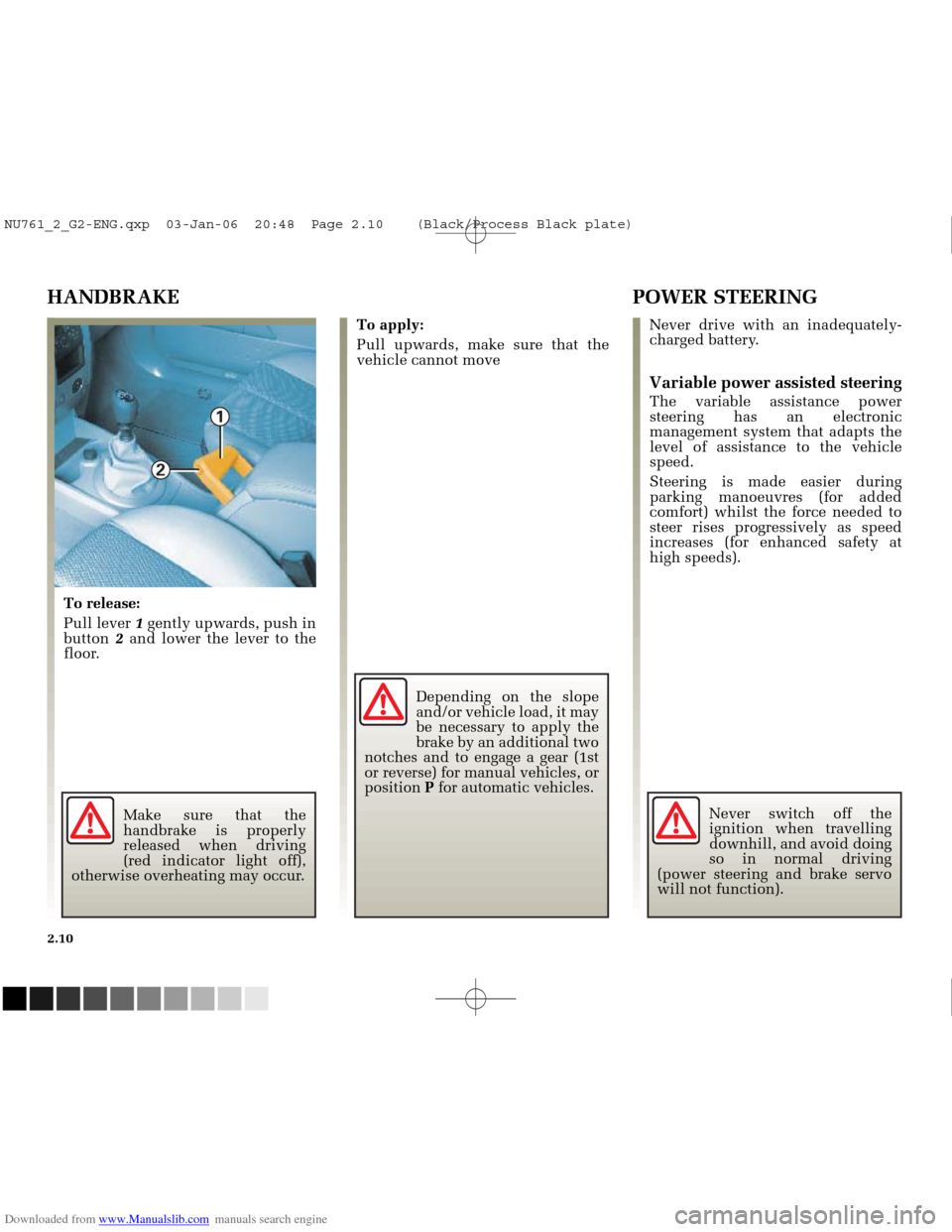
Downloaded from www.Manualslib.com manuals search engine
1
2
NU761_2_G2-FRA.qxd 4/11/05 10:48 Page 2.10
2.10
HANDBRAKE POWER STEERING
Never drive with an inadequately-
charged battery.
Variable power assisted steering
The variable assistance power
steering has an electronic
management system that adapts the
level of assistance to the vehicle
speed.
Steering is made easier during
parking manoeuvres (for added
comfort) whilst the force needed to
steer rises progressively as speed
increases (for enhanced safety at
high speeds).
To apply:
Pull upwards, make sure that the
vehicle cannot move
To release:
Pull lever 1gently upwards, push in
button 2and lower the lever to the
floor.
Make sure that the
handbrake is properly
released when driving
(red indicator light off),
otherwise overheating may occur. Depending on the slope
and/or vehicle load, it may
be necessary to apply the
brake by an additional two
notches and to engage a gear (1st
or reverse) for manual vehicles, or
position Pfor automatic vehicles.
Never switch off the
ignition when travelling
downhill, and avoid doing
so in normal driving
(power steering and brake servo
will not function).
NU761_2_G2-ENG.qxp 03-Jan-06 20:48 Page 2.10 (Black/Process Black\
plate)
Page 112 of 250
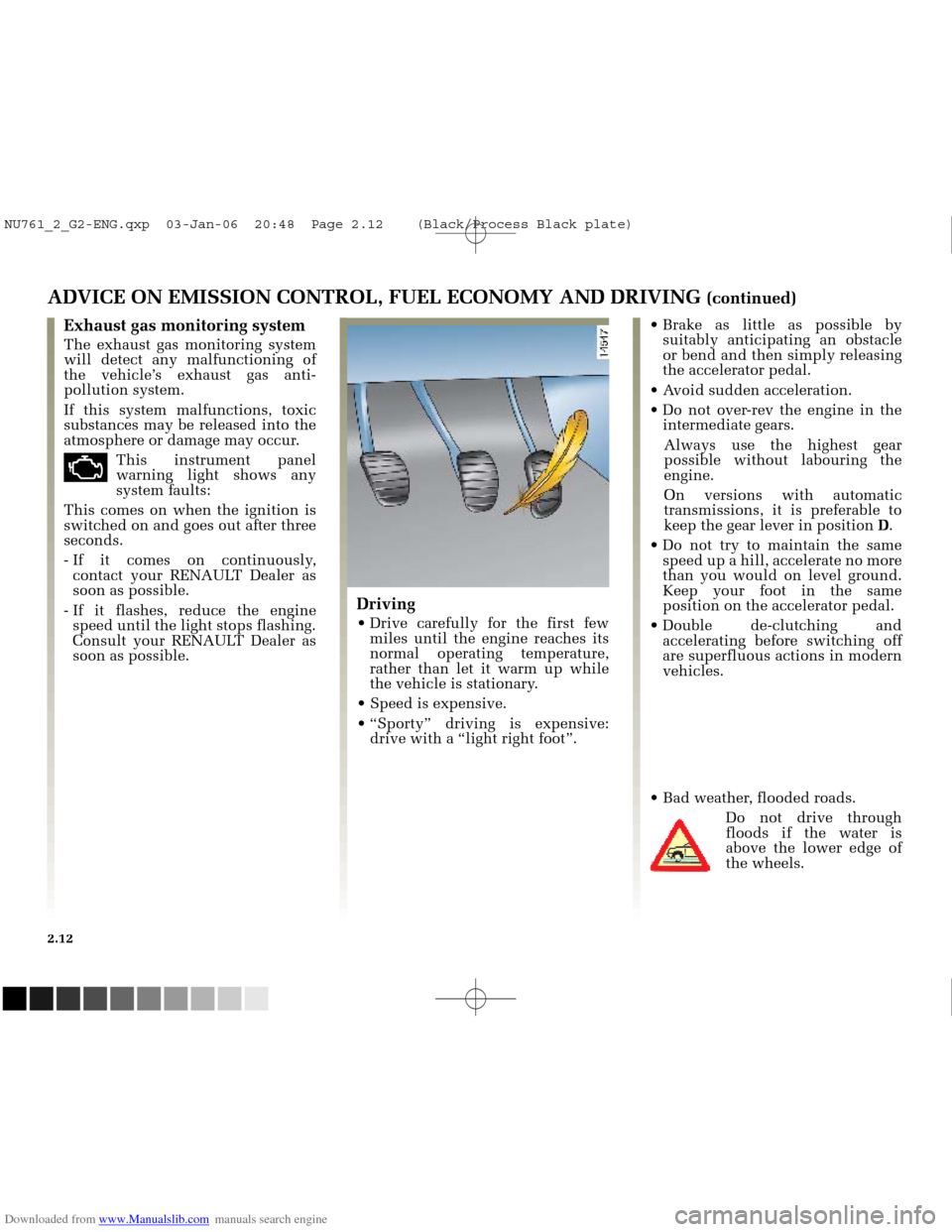
Downloaded from www.Manualslib.com manuals search engine
NU761_2_G2-FRA.qxd 4/11/05 10:48 Page 2.12
2.12
ADVICE ON EMISSION CONTROL, FUEL ECONOMY AND DRIVING (continued)
Driving
miles until the engine reaches its
normal operating temperature,
rather than let it warm up while
the vehicle is stationary.
drive with a “light right foot”.
Exhaust gas monitoring system
The exhaust gas monitoring system
will detect any malfunctioning of
the vehicle’s exhaust gas anti-
pollution system.
If this system malfunctions, toxic
substances may be released into the
atmosphere or damage may occur.
äThis instrument panel
warning light shows any
system faults:
This comes on when the ignition is
switched on and goes out after three
seconds.
- If it comes on continuously, contact your RENAULT Dealer as
soon as possible.
- If it flashes, reduce the engine speed until the light stops flashing.
Consult your RENAULT Dealer as
soon as possible.
suitably anticipating an obstacle
or bend and then simply releasing
the accelerator pedal.
intermediate gears.
Always use the highest gear
possible without labouring the
engine.
On versions with automatic
transmissions, it is preferable to
keep the gear lever in position D.
speed up a hill, accelerate no more
than you would on level ground.
Keep your foot in the same
position on the accelerator pedal.
accelerating before switching off
are superfluous actions in modern
vehicles.
Do not drive through
floods if the water is
above the lower edge of
the wheels.
NU761_2_G2-ENG.qxp 03-Jan-06 20:48 Page 2.12 (Black/Process Black\
plate)
Page 113 of 250
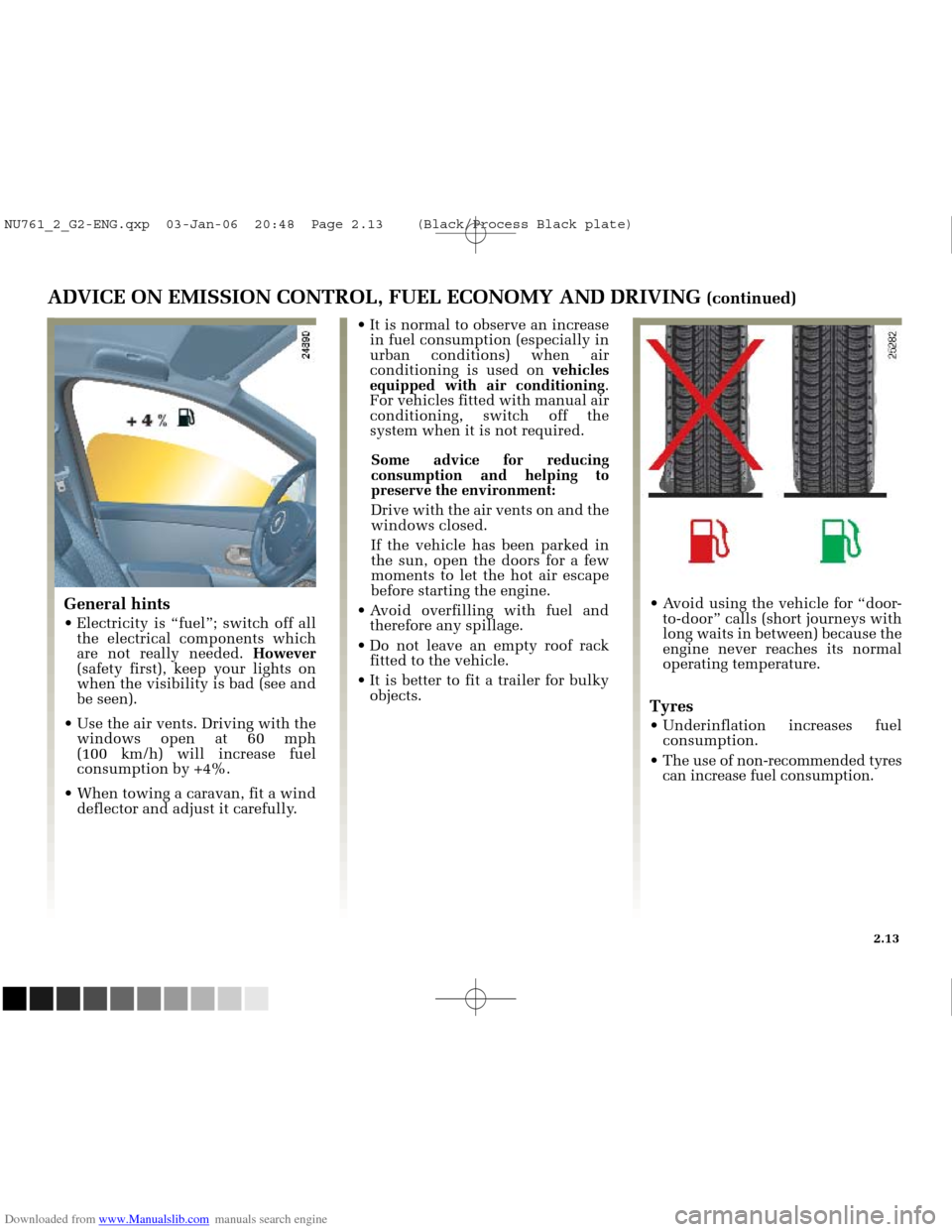
Downloaded from www.Manualslib.com manuals search engine
NU761_2_G2-FRA.qxd 4/11/05 10:48 Page 2.13
ADVICE ON EMISSION CONTROL, FUEL ECONOMY AND DRIVING (continued)
in fuel consumption (especially in
urban conditions) when air
conditioning is used on vehicles
equipped with air conditioning .
For vehicles fitted with manual air
conditioning, switch off the
system when it is not required.
Some advice for reducing
consumption and helping to
preserve the environment:
Drive with the air vents on and the
windows closed.
If the vehicle has been parked in
the sun, open the doors for a few
moments to let the hot air escape
before starting the engine.
therefore any spillage.
fitted to the vehicle.
objects.
General hints
the electrical components which
are not really needed. However
(safety first), keep your lights on
when the visibility is bad (see and
be seen).
windows open at 60 mph
(100 km/h) will increase fuel
consumption by +4%.
deflector and adjust it carefully.
to-door” calls (short journeys with
long waits in between) because the
engine never reaches its normal
operating temperature.
Tyres
consumption.
The use of non-recommended tyres can increase fuel consumption.
2.13
NU761_2_G2-ENG.qxp 03-Jan-06 20:48 Page 2.13 (Black/Process Black\
plate)